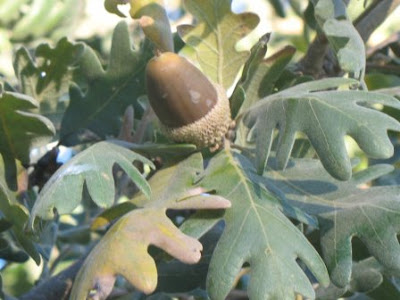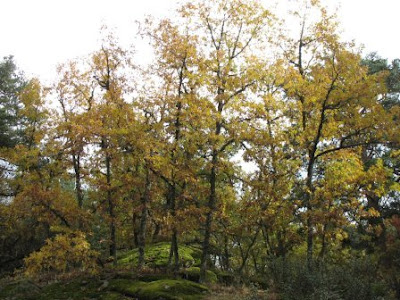 The Pyrenean Oak (sp: Quercus pyrenaica) is an oak tree species that is native to the Iberian Peninsula (Spain and Portugal). It tends to grow in clusters of small trees (clonal colonies) which are produced by this trees tendency to continually send up new stems from its base and root system. It is also common to see small forests of these trees where the individual trees are no more than 3-6 inches in diameter and only about 20 feet tall.
The Pyrenean Oak (sp: Quercus pyrenaica) is an oak tree species that is native to the Iberian Peninsula (Spain and Portugal). It tends to grow in clusters of small trees (clonal colonies) which are produced by this trees tendency to continually send up new stems from its base and root system. It is also common to see small forests of these trees where the individual trees are no more than 3-6 inches in diameter and only about 20 feet tall. The leaves of the Pyrenean oak are deeply lobed and measure about 4-5 inches in length with smooth margins. The acorns are about 1 1/8 inches long when mature and are somewhat oblong in shape. The image below is of a new acorn forming.
The leaves of the Pyrenean oak are deeply lobed and measure about 4-5 inches in length with smooth margins. The acorns are about 1 1/8 inches long when mature and are somewhat oblong in shape. The image below is of a new acorn forming. These trees are quite a sight in the fall when the leaves turn yellow and then brown. Unlike some other species the leaves of this tree do not tend to drop in the fall but hang on well into the winter during which they are blown off by the wind.
These trees are quite a sight in the fall when the leaves turn yellow and then brown. Unlike some other species the leaves of this tree do not tend to drop in the fall but hang on well into the winter during which they are blown off by the wind. Some of the leaves will still be on the tree when the new leaves form in the Spring. Like some of the other oak species in Spain the Quercus pyrenaica produces "galls" as a defense mechanism against certain wasps who lay their eggs into its bark.
Some of the leaves will still be on the tree when the new leaves form in the Spring. Like some of the other oak species in Spain the Quercus pyrenaica produces "galls" as a defense mechanism against certain wasps who lay their eggs into its bark. Although this tree is normally not very big sometimes in good conditions it can reach considerable size like the trees in the image below.
Although this tree is normally not very big sometimes in good conditions it can reach considerable size like the trees in the image below. Some other Oak tree species in Spain are the Cork Oak, the Holm Oak, the Portuguese Oak, and the English Oak.
Some other Oak tree species in Spain are the Cork Oak, the Holm Oak, the Portuguese Oak, and the English Oak.Melojo is one of the Spanish names for this tree.

Hi Dan,
ReplyDeleteWe've written about the cork oak trees in Portugal, as well as the famous Angel Oak in South Carolina. You may want to check it out.
http://www.wicanderscorkoakblog.com/2008/07/14/trees
It's called "From One Great Tree to Another--A Tribute to Conservation."
Cheers!
Team Wicanders